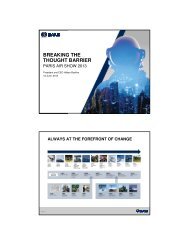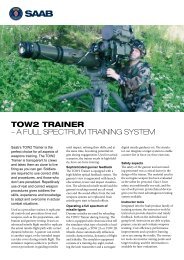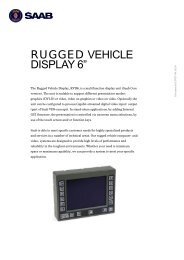financial information > notesCash flow hedgesCertain forward exchange contracts and currency swaps (hedge instruments)entered into to hedge future receipts and disbursements against currency andinterest rate risks are accounted for according to the rules for cash flow hedging.Derivatives that protect future receipts and disbursements are recognisedin the balance sheet at fair value. Changes in value are recognised directly inequity in the hedge reserve until the hedged cash flow meets the operatingprofit or loss, at which point the cumulative changes in value of the hedginginstrument are transferred to profit or loss to meet and match the effects onearnings of the hedged transaction.Interest rate exposure from future variable-rate liabilities is hedged withinterest rate swaps. In its reporting, <strong>Saab</strong> applies cash flow hedging, whichmeans that the change in value of the interest rate swap is recognised in thenet gain or loss on cash flow hedges in equity and is reported in financial revenueand expenses when transferred to profit or loss.When the hedged future cash flow refers to a transaction that will be capitalisedin the balance sheet, the net gain or loss on cash flow hedges in equity isdissolved when the hedged item is recognised in the balance sheet. If thehedged item is a non-financial asset or a non-financial liability, the reversalfrom the net gain or loss on cash flow hedges in equity is included in the originalcost of the asset or liability. If the hedged item is a financial asset or financialliability, the net gain or loss on cash flow hedges in equity is gradually reversedthrough profit or loss at the same rate that the hedged item affects earnings.When a hedging instrument expires, is sold or is exercised, or the companyrevokes the designation as a hedging relationship before the hedgedtransaction occurs and the projected transaction is still expected to occur, therecognised cumulative gain or loss remains in the net gain or loss on cashflow hedges in equity and is recognised in the same way as above when thetransaction occurs.If the hedged transaction is no longer expected to occur, the hedginginstrument’s cumulative gains and losses are immediately recognised in profitor loss in accordance with principles described above for derivatives.Fair value hedge accountingCertain forward exchange contracts and currency swaps (hedge instruments)entered into to hedge future receipts and disbursements for currency andinterest rate risk are accounted for according to the rules for fair value hedging.These hedges are recognised at fair value in the balance sheet with regardboth to the derivative itself and the future receipt or disbursement (hedgeitem) for the risk being hedged. The change in fair value of the derivative isrecognised in the profit and loss together with the change in value of thehedged item.Hedge of currency exposure in assets and liabilitiesCurrency exposure from an asset or liability is hedged with forward exchangecontracts. No hedge accounting is applied, due to which both the hedgeditem and hedging instrument are recognised at fair value with changes invalue through profit or loss. Changes in the value of operations-relatedreceivables and liabilities are recognised in operating income, while changesin the value of financial receivables and liabilities are recognised in financialrevenue and expenses.Valuation principlesThe fair value of listed financial assets is determined using market prices.Furthermore, <strong>Saab</strong> applies various valuation methods to determine the fairvalue of financial assets that are traded on an inactive market. These methodsare based on the valuation of similar instruments, discounted cash flows orcustomary valuation methods such as Black-Scholes. See Note 41.InventoriesInventories are valued at the lower of cost and net realisable value. Net realisablevalue is the estimated selling price in continuing operations after deductingestimated expenses for completion and expenses incurred in selling.Cost is calculated by applying the first-in first-out method (fifo) andincludes expenses to acquire inventory assets and bring them to their presentlocation and condition. For manufactured goods and work in progress, costincludes a reasonable share of indirect expenses based on normal capacity.For finished and semifinished goods, cost consists of direct manufacturingexpenses and a reasonable share of indirect manufacturing expenses aswell as expenses to customise products for individual customers. Calculationstake into account normal capacity utilisation.DividendsThe dividend proposed by the Board of Directors reduces earnings availablefor distribution and is recognised as a liability when the Annual GeneralMeeting has approved the dividend.Employee benefitsThe Group has two types of pension plans: defined-contribution and definedbenefitpension plans.Defined-contribution plansIn defined-contribution plans, pensions are based on the premiums paid.Obligations with regard to defined-contribution plans are expensed in theincome statement.Defined-benefit plansIn defined-benefit plans, pensions are based on a percentage of the recipient’ssalary. <strong>Saab</strong> has around ten different types of defined-benefit plans. The predominantplan is the itp plan, which accounts for approximately 5/6 of thetotal obligation. The second largest plan refers to the state-funded retirementpension and vested pensions in Affärsverket ffv when it was incorporated on1 January 1991.The Group’s net obligation for defined-benefit plans is calculated separatelyfor each plan by estimating the future compensation that employeeshave earned through employment in present and previous periods. This compensationis discounted to present value. <strong>Saab</strong> has secured main part of theobligation through provisions to a pension fund, and the fair value of thefund’s assets is offset against the provision for the pension obligation atpresent value in the balance sheet. The discount rate to calculate the commitmentat present value has been determined based on the interest rate on theclosing day for a first-class corporate bond with a maturity corresponding tothe pension obligation. When there is no active market for such corporatebonds, the market interest rate on government bonds with a similar maturityis used instead. The calculation is made by a qualified actuary using the projectedunit credit method.When the compensation terms in a plan improve, the portion of theincreased compensation attributable to the employees’ services in previousperiods is expensed through the income statement on a straight-line basisover the average period until the compensation is fully vested. If the compensationis fully vested, an expense is recognised directly through profit or loss.The obligation is estimated on the closing day, and if the calculatedamount deviates from the estimated commitment an actuarial gain or lossarises. All actuarial gains and losses as of 1 January 2004, the date of transitionto ifrs, are recognised in equity and other items in the balance sheet. Foractuarial gains and losses that arise from the calculation of the Group’s obligationfor different plans after 1 January 2004, the so-called corridor rule isapplied. This means that the portion of the cumulative actuarial gains andlosses exceeding 10 per cent of the higher of the commitments’ present valueand the fair value of assets under management is recognised over theexpected average remaining period of employment of the employees coveredby the plan. Actuarial gains and losses otherwise are not taken into account.When the calculation leads to an asset, the carrying amount is limited tothe lesser of the estimated asset and sum of unrecognised actuarial losses andunrecognised costs associated with employment in previous periods as wellas the present value of future repayments from the plan or reduced futurepayments to the plan.When there is a difference in how the pension cost is determined for alegal entity and the Group, a provision or receivable for the special employer’scontribution arises based on this difference.SeveranceA provision is recognised in connection with termination of personnel only ifthe company is obligated to terminate an employment before the customarytime, e.g., when compensation is paid in connection with a voluntary termi-76 saab annual report <strong>2009</strong>
financial information > notesnation offer. In cases where the company terminates personnel, a detailedplan is drafted containing at the minimum the workplaces, positions andapproximate number of individuals affected as well as compensation for eachpersonnel category or position and a schedule for the plan’s implementation.Share-based paymentShare-based payment refers solely to remuneration to employees, includingsenior executives. Share-based payment settled with the company’s shares orother equity instruments is comprised of the difference between the fair valueat the time these plans were issued and the consideration received. Thisremuneration is recognised as staff costs during the vesting period. To theextent the vesting conditions in the plan are tied to market factors (such asthe price of the company’s shares), they are taken into consideration in determiningthe fair value of the plan. Other conditions (such as earnings pershare) affect staff costs during the vesting period by changing the number ofshares or share-related instruments that are expected to be paid.Share matching plan for employees<strong>Saab</strong> introduced a Global Share Matching Plan for employees in autumn 2007where vesting rights accrue as of 2008. The payroll expenses for matchingshares in the plan are recognised during the vesting period based on the fairvalue of the shares. The employees pay a price for the share that correspondsto the share price on the investment date. Three years after the investmentdate, employees are allotted as many shares as they purchased three years earlierprovided that they are still employees of the <strong>Saab</strong> Group and that theshares have not been sold. In certain countries, social security expenses arepaid on the value of the employee’s benefit when matching takes place. Duringthe vesting period, provisions are allocated for these estimated socialsecurity expenses. Share repurchases to fulfil the commitments of <strong>Saab</strong>’sshare matching plans are recognised in equity. During the autumn 2008 anadditional share matching program was introduced with the same conditionsas the programme introduced 2007.In addition, a performance-based plan was introduced for senior executivesentitling them to 2–5 matching shares depending on the category theemployee belongs to. In addition to the requirement that the employeeremain employed by <strong>Saab</strong> after three years, there is also a requirement thatearnings per share grow in the range of 5 to 15 per cent. See also, Note 37.ProvisionsA provision is recognised in the balance sheet when the Group has a legal orinformal obligation owing to an event that has occurred and it is likely that anoutflow of economic resources will be required to settle the obligation and areliable estimate of the amount can be made. Where it is important when intime payment will be made, provisions are estimated by discounting projectedcash flow at a pre-tax interest rate that reflects current market estimatesof the time value of money and, where appropriate, the risks associatedwith the liability.GuaranteesA provision for guarantees is normally recognised when the underlyingproducts or services are sold if a reliable calculation of the provision can bemade. The provision is based on historical data on guarantees for the productsor similar products and an overall appraisal of possible outcomes in relationto the likelihood associated with these outcomes.RestructuringA provision for restructuring is recognised when a detailed, formal restructuringplan has been established and the restructuring has either begun orbeen publicly announced. No provision is made for future operating losses.Soil remediationIn accordance with the Group’s publicly announced environmental policyand applicable legal requirements, periodic estimates are made of <strong>Saab</strong>’s obligationsto restore contaminated soil. Anticipated future payments are discountedto present value and recognised as a provision.Loss contractsA provision for a loss contract is recognised when anticipated benefits are lessthan the unavoidable costs to fulfil the obligations as set out in the contract.Contingent liabilitiesA contingent liability exists if there is a possible commitment stemming fromevents whose occurrence is dependent on one or more uncertain futureevents and there is a commitment that is not recognised as a liability or provisionbecause it is unlikely that an outflow of resources will be required or thesize of the obligation cannot be estimated with sufficient reliability. Informationis provided as long as the likelihood of an outflow of resources is notextremely small.TaxesIncome taxes consist of current tax and deferred tax. Income taxes are recognisedin profit or loss unless the underlying transaction is recognised in netcomprehensive income or loss, in which case the related tax effect is also recognisedin net comprehensive income or loss.Current tax is the tax paid or received for the current year, applying thetax rates that have been set or essentially set as of the closing day to taxableincome and adjusting for current tax attributable to previous periods.Deferred tax is calculated according to the balance sheet method based ontemporary differences that constitute the difference between the carryingamount of assets and liabilities and their value for tax purposes. Deductibletemporary differences are not taken into account in the initial reporting ofassets and liabilities in a transaction other than a business combination andwhich, at the time of the transaction, do not affect either the recognised or taxableresult. Moreover, temporary differences are not taken into account if theyare attributable to shares in subsidiaries and associated companies that are notexpected to be reversed within the foreseeable future. The valuation ofdeferred tax is based on how the carrying amounts of assets or liabilities areexpected to be realised or settled. Deferred tax is calculated by applying the taxrates and tax rules that have been set or essentially are set as of the closing day.Deferred tax assets from deductible temporary differences and tax losscarry forwards are only recognised to the extent it is likely that they will beutilised. The value of deferred tax assets is reduced when it is no longer consideredlikely that they can be utilised.Significant differences between the Group’s and the Parent Company’saccounting principlesThe Parent Company follows the same accounting principles as the Groupwith the following exceptions.Associated companies and joint venturesShares in associated companies and joint ventures are recognised by the ParentCompany according to the acquisition value method. Revenue includesdividends received.Intangible fixed assetsAll development costs are recognised in profit or loss.Tangible fixed assetsTangible fixed assets are recognised after revaluation, if necessary. All leasesare recognised according to the rules for operating leasing.Borrowing costsThe Parent Company recognises borrowing costs as an expense in the periodin which they arise.Investment propertiesInvestment properties are recognised according to acquisition cost method.Financial assets and liabilities and other financial instrumentsThe Parent Company carries financial fixed assets at cost less impairment andfinancial current assets according to the lowest value principle. If the reasonfor impairment has ceased, it is reversed.The Parent Company does not apply the rules for setting off financialassets and liabilities.saab annual report <strong>2009</strong> 77


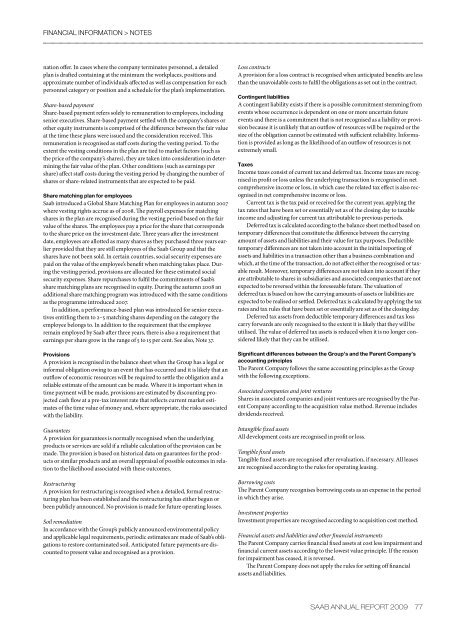

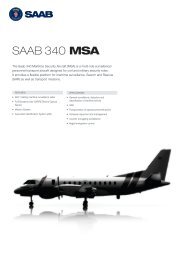
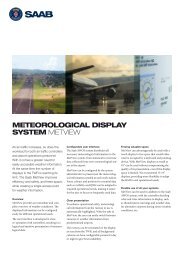
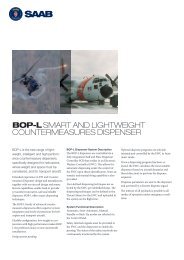



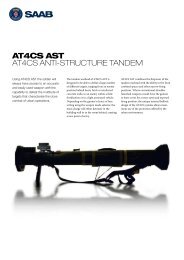


![Proposal long-term incentive programs [pdf] - Saab](https://img.yumpu.com/50411723/1/190x245/proposal-long-term-incentive-programs-pdf-saab.jpg?quality=85)
